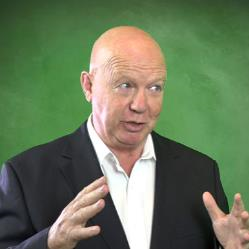 "The skills and techniques used to effectively converse with the customer" - interview by John Smibert.
"The skills and techniques used to effectively converse with the customer" - interview by John Smibert.
Recently Dean Kelly and I discussed the need for many salespeople to change the way they have a conversation with potential customers.
 He said the salesperson needs to conduct a conversation where she can help the client understand that she has some business understanding of problems the customer is facing, and that she is equipped with the capability to help the customer solve them - and do all this without telling the customer - because telling is not selling.
He said the salesperson needs to conduct a conversation where she can help the client understand that she has some business understanding of problems the customer is facing, and that she is equipped with the capability to help the customer solve them - and do all this without telling the customer - because telling is not selling.
In this discussion I asked Dean to talk about how a salesperson can do this - how they can change the conversation.
He emphasises how to use of open questions, how to be situationally agile, and how to use visual representations to kick the conversation off on the right footing.
His recommendations are very pragmatic and insightful - I think you'll like it.
See the full interview to learn more. This interview is likely to be valuable for sales leaders, sales managers and salespeople.
****************
Dean Kelly is the Sales Deal Mechanic.
Interview
John: Hey, I've got Dean Kelly with me again - welcome back, Dean!
Dean: Thank you for having me again, John!
John: Hey Dean, last time we had a great discussion about change the conversation in a sales environment - and I loved that, thank you very much - and at the end of it we said, "Okay, we really need to talk about how you change the conversation." Could you talk a little bit about some of the things you recommend that salespeople need to do to change the conversation?
Dean: Absolutely. There's a couple of key ingredients that I find are critical in doing this. Number one, it's being able to ask good, open questions. One of the biggest challenges for salespeople is under pressure we ask closed questions which generally stunt the conversation, or we get so caught up in our inner monologue, trying to think of, "Wow, that was a really good first question I asked, John! How am I going to follow that up with another good one?" that we get caught up in that and we now lose that authentic moment that we're sharing with the client.
John: A lot of people would say that you should script out all the questions and be ready to go from one to the next.
Dean: I don't know what your experience is with having done that, but I've found that... on the maturity model, as a salesperson we go through that phase where we try to script them out.
John: I'm glad you say that - I totally agree.
Dean: The challenge is, more often than not, the situation doesn't come up for that question in the format that you wrote it, so my view now is to be more situationally agile and create a conversation where you have more time. So, number one is being adept at asking open questions, that's a really critical first step. The second one I find now is using a visual type of representation to kick the conversation off.
 John: And you're not talking a brochure or something... [laughs]
John: And you're not talking a brochure or something... [laughs]
Dean: No, I'm not talking a brochure. I look at two key ones, one I call just the megatrends slide if you will. It's just a picture and it has a number of issues that are affecting the client or clients like them in the current world.
John: Their industry or whatever.
Dean: Yes, high-level ones that are affecting their industry. It may be cloud, it may be a shift in consumer towards mobile and that has a fundamental change in their behaviour. If they move into mobile, obviously security comes in, we're having a lot of news about security breaches and data being lost, so obviously security is there as well. If you're in the visual environment it may be to do with moving to 4k from a media perspective and that's fundamentally changing the quality of stuff you publish. Those things may be there in a picture.
 John: Okay. So it's an open-ended questions that are based around the megatrends, which I assume are going to be aligned to whatever research you've done on the customer, so you know they're probably going to have opinions and issues in the areas of the megatrends.
John: Okay. So it's an open-ended questions that are based around the megatrends, which I assume are going to be aligned to whatever research you've done on the customer, so you know they're probably going to have opinions and issues in the areas of the megatrends.
Dean: Correct. And then it's about getting the conversation going where you serve to get the conversation started, which may be introducing them. "Hey John, these megatrends are what our customers are telling us are either the greatest challenge or the greatest opportunity their company is trying to take advantage of. As you look at this list, which would be the number one for you, either as a challenge or that opportunity?"
John: "And why?"
Dean: Exactly. So you're going to get it going, and then I may respond then with open questions, and instead of thinking of the long question that I've got to ask, it's actually breaking them down to far shorter, more open questions so I can keep the conversation. If you thought of this as a badminton game for example, keep the rally going in a natural way where I can authentically be present with the client, we're focusing on them, we're focusing on their business, and we're during that process uncovering areas that may be opportunities for us to create value for that client.
 John: And one of the issues I find with a lot of salespeople is they want to move it quickly. It's much better to actually slow it down, isn't it?
John: And one of the issues I find with a lot of salespeople is they want to move it quickly. It's much better to actually slow it down, isn't it?
Dean: Absolutely. I've been doing a little bit of research on this for myself. If I have a meeting that goes for less than an hour, where I'm in a hurry to get out - maybe my car is parked in a 60-minute block - what I find is that meeting doesn't actually go as well as being in the moment with the client and allowing the conversation to flow. And even if it goes overtime or even if the client says, "Hey look, I can't continue this, but I definitely want you back," that in itself is a great advance into the next meeting. So, setting it up and authentically being there and having this conversation is in the customer's best interest too, and generally they reward you by wanting you to come back or extending the time that you have, and that just leads to a better qualified opportunity.
John: You used a word that I love there, and that's being authentic. One of the issues I find with a lot of salespeople is they try to be somebody that they're not and they don't sit back and relax and be themselves. They have enormous, unique value, every person does, and if I can authentically bring that to the table and then in a relaxed way have a conversation and use my domain knowledge to change the conversation with the questions I ask, then it's going to be very valuable for the customer.
Dean: Absolutely. And that puts paid to having the prepared questions, because prepared questions completely undermine that authenticity of being in the moment and going where the flow goes. And the visual one allows you to actually ask questions, rather than dynamically trying to keep four or five balls in the air simultaneously using only words - it makes it too hard.
John: Alright. So, the bottom line is the how- using open-ended questions and using megatrends type visuals that help generate that discussion and that conversation, and then authentically and in a relaxed way having a good, solid conversation. And bringing your value to the table, your commercial insights through the questions you ask, not telling them.
Dean: As much as you can.
John: As much as you can. Hey Dean, that was a great 'conversation' and I look forward to the next one. Let's continue this subject - I'd like to really explore this a lot more.
Dean: Okay, my pleasure - thank you, John!
John: Thanks, Dean!
****************
More of Dean Kelly:
****************

Your Invitation: I invite you to join the Sales Leader Forum group on LinkedIn where you can experience informative discussions with your peers and sales thought leaders on subjects like the one we have discussed here. I also invite you to subscribe to the
- Sales Leader Resource Centre here
- Sales Leader YouTube channel here (300+ sales leadership videos)
Please Share: If you valued this article, please share via your Twitter, LinkedIn, Google+ and Facebook social media platforms. I encourage you to join the conversation or ask questions. So feel free to add a comment on this post - I promise to respond. If inclined please follow my LinkedIn post page here.
Want to touch base? If you have questions please feel free to contact me - email: john.smibert(at)salesleaderforums.com, Phone: +61 404857893 or Skype: john.smibert